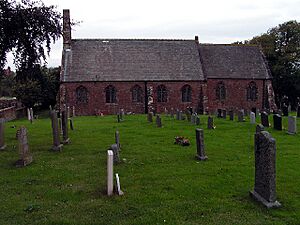St James' Church, Hayton facts for kids
St James Church in Hayton, Cumbria, is an active Anglican church. It is part of the Church of England and serves the local community. This church was built in the 1800s.
Contents
Where is St James Church?
The small village of Hayton is in Cumbria. It is about two miles southwest of Aspatria. You can find it half a mile northwest of Prospect. Signs from the A596 road will guide you there. The church is right in the middle of the village. It sits on the south side of the village green.
About St James Church
Hayton's parish church is named after Saint James. It is one of several churches in the Solway area. The Bishop of Carlisle helps oversee these churches.
Before 1868, Hayton village was part of the parish of Aspatria. This meant people had to walk two miles to worship at St. Kentigern’s Church. This was also where the Musgrave family had their private chapel.
However, in 1868, Hayton became its own church district. This happened because of a law called the New Parishes Act 1856. After this, Hayton became a separate parish. It included nearby villages like Allerby, Outerside, and Prospect. It also covered a small part of the Solway Coast at Mealo and many farms.
Building the Church
The land for the church was given by Mr. Blackburn, who lived at Hayton Castle. The church was designed by architects from Manchester. It cost about £1,300 to build. The first stone was laid on May 3, 1865. The church was officially opened on November 5, 1867.
The church's design mixes two old English styles: early decorative and Gothic. It is built from local red sandstone. The roof inside shows its wooden beams. The church was made to hold 230 people.
Inside the Church
The church has a main area called the nave and a special area for the altar called the chancel. A beautiful arch separates these two parts. The nave is about 16.6 meters long and 7.8 meters wide. The chancel is a bit smaller, about 8.4 meters long and 6.4 meters wide.
Inside, the church feels large and is well cared for. A lovely wrought iron screen divides the nave from the chancel. There are also two beautiful Stained glass windows. These windows let in lots of colorful light.
- The window at the east end shows Jesus going up to heaven. It honors Ann Blackburn of Hayton Castle. The iron screen was also put up in her memory.
- The west window was added by Joseph Hetherington. He dedicated it to his wife and three children. This window has three sections. The middle section shows Christ blessing children. Below that, he is seen in the house of Simon the Leper. The north section shows Christ as the Light of the World. This is a copy of a famous painting. The south section shows Christ as the Good Shepherd.
- There is also a two-section window. It shows Jesus carrying the cross and the crucifixion. This window was put in by church members and friends. It remembers Thomas Thwaites, who was the first rector of Hayton. He passed away on November 22, 1884.
The lectern, which is a stand for reading, looks like an eagle. It was a gift from Mrs. Todd of Hayton. The wooden pulpit on the north side was carved by hand. There is also a reading desk on the south side.
A special screen behind the altar, called a reredos, was put up in 1875. People paid for it to remember John Atkinson. He was a church leader who helped organize the building of the church.
The font, used for baptisms, is very old, over 800 years! It stands near the church porch. This interesting old item used to be in the chapel at Hayton Castle. The pipe organ was put in as a war memorial. The rectory, which was the home for the church leader, is now a private house. It was a gift from the Bishop of Carlisle.
St James Church Today
Today, St James Church holds Sunday worship services. They also have regular social events. There is an active church council where members from three parishes work together. They have activities like Mothers' Union meetings and study groups. The church also has strong connections with the local primary school at Oughterside.


